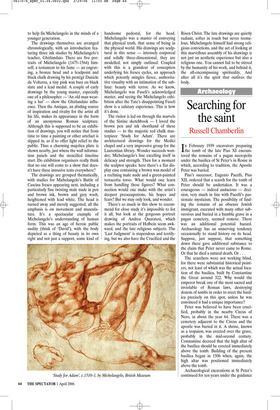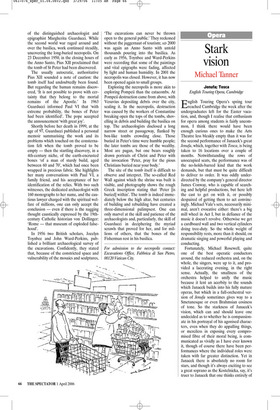Searching for the saint
Russell Chamberlin
In February 1939 excavators preparing the tomb of the late Pius XI encountered the remains of a pagan necropolis under the basilica of St Peter’s in Rome in which, according to tradition, the Apostle Peter was buried.
Pius’s successor, Eugenio Pacelli, Pius XII, ordered that a search for the tomb of Peter should be undertaken. It was a courageous — indeed audacious — decision, very much in line with Pacelli’s passionate mysticism. The possibility of finding the remains of an obscure Jewish immigrant, executed with many other subversives and buried in a humble grave in a pagan cemetery, seemed remote. There was an additional potential hazard. Archaeology has an unnerving tendency occasionally to stand history on its head. Suppose, just suppose, that something down there gave additional substance to the claim that Peter never came to Rome. Or that he died a natural death. Or ...
The searchers were not working blind, for there were substantial historical pointers, not least of which was the actual location of the basilica, built by Constantine the Great around 322. Why would the emperor break one of the most sacred and inviolable of Roman laws, destroying dozens of tombs in order to erect the basilica precisely on this spot, unless he was convinced it had a unique importance?
Peter was believed to have been crucified, probably in the nearby Circus of Nero, in about the year 64. There was a cemetery adjacent to the Circus and the apostle was buried in it. A shrine, known as a tropaion, was erected over the grave, probably in the mid-second century. Constantine decreed that the high altar of the basilica should be erected immediately above the tomb. Building of the present basilica began in 1506 when, again, the high altar was positioned immediately above the tomb.
Archaeological excavations at St Peter’s continued for ten years under the guidance of the distinguished archaeologist and epigraphist Margherita Guarducci. While the second world war raged around and over the basilica, work continued steadily, uncovering the long-buried necropolis. On 23 December 1950, in the closing hours of the Anno Santo, Pius XII proclaimed that the tomb of St Peter had been discovered.
The usually autocratic, authoritative Pius XII sounded a note of caution: the tomb itself had undoubtedly been found. But regarding the human remains discovered, ‘It is not possible to prove with certainty that they belong to the mortal remains of the Apostle.’ In 1963 Guarducci informed Paul VI that ‘with extreme probability, the bones of Peter had been identified’. The pope accepted the announcement ‘with great joy’.
Shortly before her death in 1999, at the age of 97, Guarducci published a personal memoir summarising the work and its problems which touched on the consternation felt when the tomb proved to be empty — then the startling discovery, in a 4th-century niche, of the earth-encrusted bones ‘of a man of sturdy build, aged between 60 and 70’, which had once been wrapped in precious fabric. She highlights her many conversations with Paul VI, a family friend, and his acceptance of her identification of the relics. With two such witnesses, the dedicated archaeologist with 160 monographs to her name, and the cautious lawyer charged with the spiritual welfare of millions, one can only accept the conclusion — even if there is the nagging thought caustically expressed by the 19thcentury Catholic historian von Dollinger: ‘Rome — that museum of exploded falsehood’.
In 1956 two British scholars, Jocelyn Toynbee and John Ward-Perkins, published a brilliant archaeological survey of the excavations. Confidently, they stated that, because of the constricted space and vulnerability of the mosaics and sculptures, ‘The excavations can never be thrown open to the general public.’ They reckoned without the juggernaut of tourism; AD 2000 was again an Anno Santo with untold thousands pouring into the basilica. As early as 1956, Toynbee and Ward-Perkins were recording that some of the paintings and vital epigraphs were fading, affected by light and human humidity. In 2001 the necropolis was closed. However, it has now been opened again to small groups.
Exploring the necropolis is more akin to exploring Pompeii than the catacombs. At Pompeii destruction came from above, with Vesuvius depositing debris over the city, sealing it. In the necropolis, destruction was caused by the workers of Constantine breaking open the tops of the tombs, shovelling in debris and building the basilica on top. The archaeologists disclosed a long narrow street or passageway, flanked by box-like tombs crowding close. Those buried in Peter’s time were humble people; the later tombs are those of the wealthy. Most are pagan, but one bears roughly drawn portraits of Christ and Peter with the invocation ‘Peter, pray for the pious Christians buried near your body.’ The site of the tomb itself is difficult to observe and interpret. The so-called Red Wall against which the shrine was built is visible, and photography shows the rough Greek inscription stating that ‘Peter [is buried] within’. The tomb is indeed immediately below the high altar, but centuries of building and rebuilding have created a three-dimensional palimpsest. One can only marvel at the skill and patience of the archaeologists and, particularly, the skill of Guarducci in deciphering the myriad scrawls that proved for her, and for millions of others, that the bones of the Fisherman rest in his basilica.



























































































 Previous page
Previous page